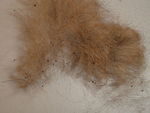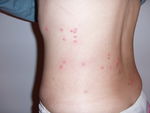Difference between revisions of "Flea Habitat and Control"
| Line 9: | Line 9: | ||
Control of flea infestations does not involve only the affected animal as the majority of the population is fee living in the environment. A single treatment or occasional treatment of the animal will provide temporary relief but will not control the issue. In order to properly control the several stages must be followed in order to remove the initial infestation and prevent re-infestation. | Control of flea infestations does not involve only the affected animal as the majority of the population is fee living in the environment. A single treatment or occasional treatment of the animal will provide temporary relief but will not control the issue. In order to properly control the several stages must be followed in order to remove the initial infestation and prevent re-infestation. | ||
| − | + | Flea control must look at eliminating all stages of the flea life cycle rather than just those on the host. Animals must be protected against reinfection from within the home and in the environment. | |
| − | + | In the home: | |
| − | + | Flea larvae can survive consuming flea dirt and other debris in carpet and upholstery. These areas should be treated with [[Ectoparasiticides]] in the form of sprays or foggers. This should be done in conjunction with regular treatment of the host animal, which will kill hatched fleas as they attack the animal. In the outdoor environment entomophagous nematodes can be used to destroy parasite eggs as this is their food supply. | |
| − | |||
| − | |||
| − | |||
| − | + | On the animal: | |
| − | + | Adulticide treatments should be used on infected animals, some of these may also have larvicidal effects and so destroy earlier life stages before more eggs can be laid. | |
| − | |||
| − | |||
| − | |||
| − | |||
| − | |||
| − | |||
| − | |||
| − | |||
| − | + | To prevent resistance occurring, control methods should not rely solely on chemical methods. Hygiene such as regular vacuuming and washing of the animal's bedding should also occur for the most effective treatment. | |
| − | |||
| − | |||
| − | |||
[[Category:Fleas|C]] | [[Category:Fleas|C]] | ||
[[Category:To_Do_-_Parasites]] | [[Category:To_Do_-_Parasites]] | ||
[[Category:To_Do_-_NickJ]] | [[Category:To_Do_-_NickJ]] | ||
| + | |||
| + | [[Category:To_Do_-_Review]] | ||
Revision as of 12:20, 6 August 2010
| This article is still under construction. |
Habitats
Although adult fleas are obligate blood feeders only 5% of the flea population will be on an animal at any one time. The remaining population inhabits the surrounding environment, though they are never far from a potential host species. The population that is not on the host consists of eggs, larvae, pupae and unfed adults. In the environment the adult fleas as well as the other stages are found in 'hot spots' where a potential host animal spends most of its time. These areas are usually warm, shady and humid and therefore usually indoors in regions with a cooler climate. It is common to find large numbers of eggs in areas where cats land after jumping as this dislodges the eggs from the hair.
Control
Control of flea infestations does not involve only the affected animal as the majority of the population is fee living in the environment. A single treatment or occasional treatment of the animal will provide temporary relief but will not control the issue. In order to properly control the several stages must be followed in order to remove the initial infestation and prevent re-infestation.
Flea control must look at eliminating all stages of the flea life cycle rather than just those on the host. Animals must be protected against reinfection from within the home and in the environment.
In the home:
Flea larvae can survive consuming flea dirt and other debris in carpet and upholstery. These areas should be treated with Ectoparasiticides in the form of sprays or foggers. This should be done in conjunction with regular treatment of the host animal, which will kill hatched fleas as they attack the animal. In the outdoor environment entomophagous nematodes can be used to destroy parasite eggs as this is their food supply.
On the animal:
Adulticide treatments should be used on infected animals, some of these may also have larvicidal effects and so destroy earlier life stages before more eggs can be laid.
To prevent resistance occurring, control methods should not rely solely on chemical methods. Hygiene such as regular vacuuming and washing of the animal's bedding should also occur for the most effective treatment.

